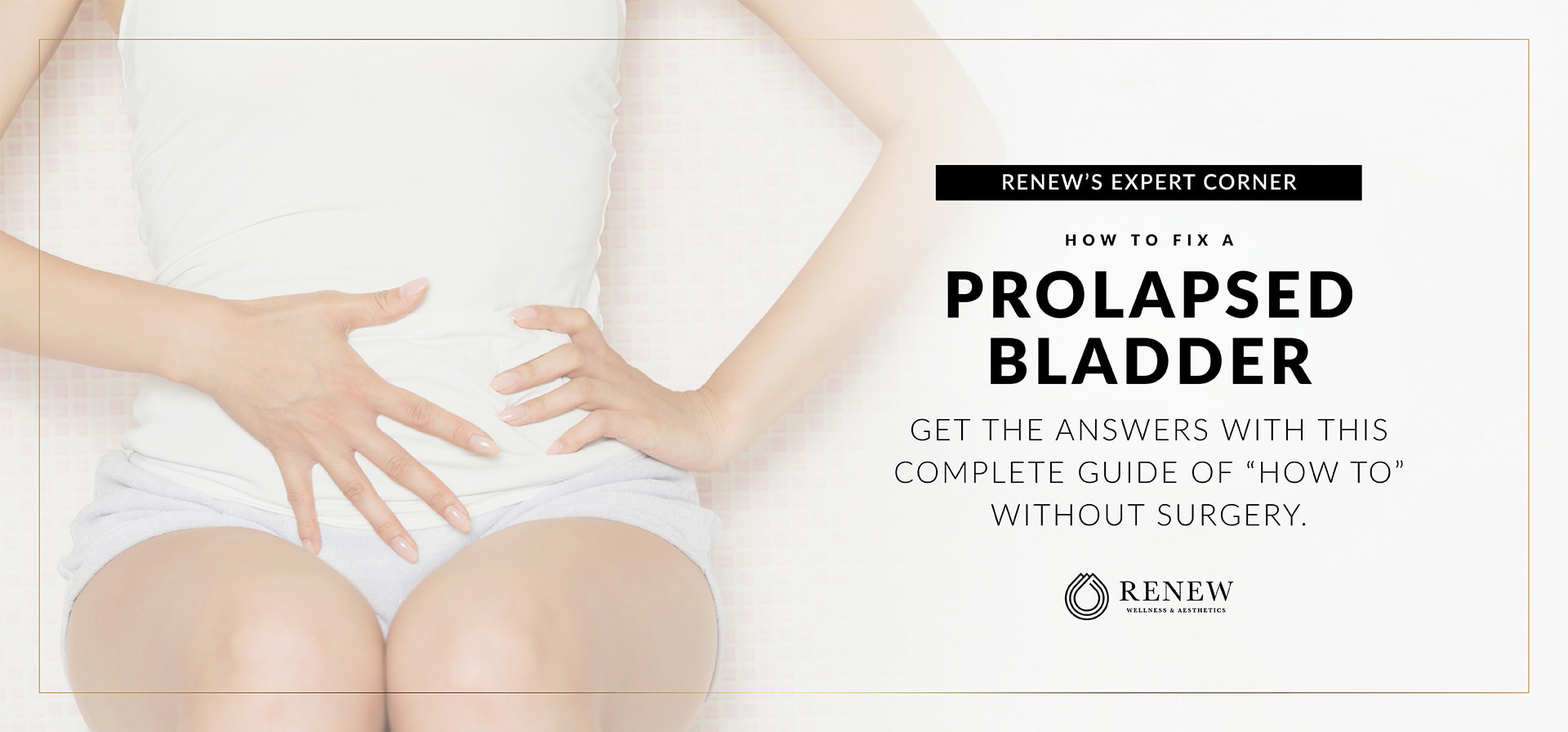The human body is amazing and strong. However, it goes through many changes as a result of aging and normal wear and tear, not to mention childbirth for women. In fact, one of the common problems that women in particular face is a prolapsed bladder. It affects nearly 40% of women in the United States but can also affect men.
This condition is uncomfortable and usually requires treatment. Thankfully, there are non-invasive options that men and women can take advantage of as an alternative to surgery.
With that in mind, if you’re experiencing pelvic floor prolapse, this guide has the answer. Keep reading to discover your options and treatments available at Renew Wellness & Aesthetics.
What Is a Prolapsed Bladder?
Do both men and women suffer from prolapse?
Prolapsed Bladder Symptoms in Women:
In women, this includes the weakening of vaginal tissues. The bladder is held in place by the pelvic floor muscles and tissues within women. But when prolapse occurs, the tissues are stretched, become weak and cause the pelvic floor to drop and bulge into the vagina. It causes a hernia, and many women experience pressure in the vaginal area too.
This condition is also called a dropped uterus, dropped vagina, or a dropped rectum. Medical professionals refer to it as a cystocele.
Prolapse usually occurs as a result of pregnancy and childbirth. On the other hand, it happens to women who have never had kids as well. Additionally, prolapse is the side effect of chronic constipation, repetitive heavy lifting, severe coughing, and poor tissue integrity. It also occurs due to aging and menopause.
In addition to a bulge in the vaginal area, there are other symptoms associated with pelvic floor prolapse.
Symptoms include the following:
- A constant urge to urinate
- Urinary incontinence
- Discomfort or pain during sex
- Tissue protruding out of the vagina
- Frequent urinary tract infections
- Feeling additional weight or pressure in the vaginal area
- Pain in the pelvis, groin, vagina, lower back, and lower belly
Prolapsed Bladder Symptoms in Men:
- Male urinary dysfunction: This condition can involve leaking urine after peeing, frequent urination and other bladder and bowel issues.
- Erectile Dysfunction (ED): ED is when men can’t get or maintain an erection during sex. Sometimes pelvic muscle tension or pain can contribute to this issue.
- Prostatitis: Pelvic floor dysfunction and prolapse symptoms closely resemble prostatitis, which is an infection or inflammation of the prostate. Prostatitis can have many causes including bacteria, sexually transmitted infections or trauma to the nervous system.
Symptoms include the following:
- Pelvic pressure
- Heaviness, fullness, pressure
- A sense that something is falling out
- Trouble emptying your bowel or bladder completely
- Urine leakage, frequency, chronic urinary tract infections, difficulty urinating
- Protrusion of the rectum out of the anus
- Difficult bowel movements or trapping of stool
- Lower backache
Non-Invasive Prolapse Treatments for Prolapsed Bladder
In most cases, a prolapsed bladder is a mild condition. It’s usually up to the discretion of the patient as to when to get the condition treated. However, if it’s left unattended, the condition could get worse over time.
In regard to postpartum bladder prolapse, new symptoms usually disappear within a year after delivery. The only time that the condition is considered severe is when there is urinary retention and the bladder is unable to empty itself. In this situation, the problem could lead to kidney damage or infection, and treatment is mandatory. However, urgent medical attention due to urinary tract infection is rare.
As previously stated, you don’t need to have surgery to treat a prolapsed bladder. There are non-invasive treatments that you can do to correct the issue, including the following:
-
Pelvic Floor Prolapse Exercises
Since the pelvic floor supports the bladder, strengthening it helps to improve prolapse. Kegel exercises are most effective in tightening the pelvic floor. Not only that, but they can be done at home or anywhere. To perform the exercise, make sure your bladder is empty and squeeze your pelvic muscles. They are the same muscle group you’d clench when trying to hold in urine. Tighten for three to five seconds and release. Repeat this exercise about 10 times and do it three times per day. While pelvic floor exercises are helpful, they’re not always a successful form of treatment. If your prolapsed bladder is beyond mild, it’ll require something more effective.
-
Pessary
A pessary is a plastic device that’s inserted into the vagina to provide compression and offer urethral support. It’s a non-invasive option that helps to lift the bladder and apply compression to the urethra so that there is no leakage. Pessaries come in a variety of sizes and shapes to accommodate individual support. Women who receive this treatment often need estrogen tablets, cream, or a ring to tighten the vaginal skin—especially those going through menopause. Incorporating estrogen helps to minimize the risk of ulceration or vaginal skin erosion. Getting a pessary isn’t the best option. It requires continual care and there is a high risk of vaginal infection and bleeding. Not to mention if a pessary isn’t properly cared for, it can cause erosion within the bladder, rectum, or vaginal wall. Only half of the women who receive this treatment continue with it on a long-term basis.
-
FDA Approved, Emsella Treatments
Unlike the treatment options above, Emsella offers incredible benefits. This method uses high-velocity electronic magnetic fields to trigger motor neurons in the pelvic floor. It provides deep penetration into the targeted tissues in the pelvic floor, and it stimulates the muscles. It is FDA-approved for both men’s and women’s urinary incontinence. Not only that, but it’s non-invasive, which makes it a great option. Emsella provides better results than basic pelvic floor exercises, and it doesn’t pose as much of a risk as getting a pessary. Not to mention, this treatment is comfortable. You sit on the Emsella chair, fully-clothed while the electronic waves work their magic. In about three weeks, you should notice a difference because this treatment restores the pelvic organs and builds muscle strength. Commonly referred to as the “Kegel throne”, this treatment option is one of the very best non-invasive options available. Furthermore, Emsella tightens vagina walls, minimizes urinary incontinence, and enhances sexual satisfaction. If you’re looking for a treatment that is effective but doesn’t require surgery or cause uncomfortable side effects, this is it.
The Best Treatment for Prolapsed Bladder
Are you suffering from a prolapsed bladder? If so, Renew Wellness & Aesthetics can help you determine the best treatment for you. In addition, we offer a variety of sexual wellness services for both men and women.
If you have any questions for us, call 405-810-5944 or schedule a consultation online. We look forward to helping you get rejuvenated and feel your best!

